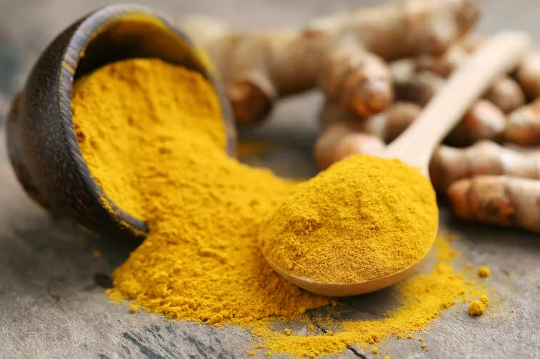
A maioria dos benefícios de saúde relatados pela cúrcuma está ligada a compostos chamados curcuminóides. tarapong srichaiyos/ Shutterstock
Açafrão tem sido usado por humanos há mais de 4,000 anos. Assim como na culinária e na cosmética, tem sido um elemento básico da prática da medicina tradicional Ayurveda, usada para tratar uma variedade de condições desde artrite ao vento.
Ainda hoje, a cúrcuma continua sendo um suplemento de saúde popular. Há uma abundância de artigos e postagens de mídia social reivindicando os benefícios deste tempero para tudo, desde função cerebral para dor reduzindo e inflamação.
Mas enquanto algumas dessas alegações estão ligadas a evidências, a maior parte dessa pesquisa é em células e animais, tornando os efeitos reais em humanos menos claros.
Embora seja relatado que a cúrcuma contém mais de 100 compostos diferentes, a maioria de seus benefícios à saúde relatados está ligada a compostos específicos chamados curcuminóides (o mais abundante é a curcumina).
Os curcuminóides são compostos fenólicos, que são moléculas que as plantas costumam produzir como pigmentos ou para desencorajar os animais de comê-las. É isso que dá ao açafrão sua cor distinta, mas também pode alterar o funcionamento das células.
Muitos dos potenciais efeitos da cúrcuma na saúde foram associados a esses compostos fenólicos que, em laboratório, demonstraram ter um efeito antioxidante.
Os antioxidantes são substâncias que previnem ou retardam os danos causados pelos radicais livres – um tipo de molécula nociva que pode causar inflamação e também tem sido associada a doença cardíaca e Câncer.
Mas, embora a cúrcuma realmente atue como um antiinflamatório, muitos dos benefícios à saúde causados por esse efeito só foram comprovados em laboratório (usando células) ou em animais.
Por exemplo, um estudo alimentado ratos obesos um grama de curcumina por quilograma de peso corporal. Após 12 semanas, eles descobriram que os camundongos que receberam curcumina apresentaram melhorias semelhantes na função cerebral e níveis mais baixos de inflamação no fígado do que os camundongos que estavam em uma dieta para perda de peso.
Portanto, embora isso possa ter se traduzido em camundongos mais saudáveis, não está claro se o mesmo seria verdade em humanos. Sem mencionar que, se este estudo tivesse sido conduzido em humanos, uma pessoa média de 70 kg precisaria consumir mais de 2kg de açafrão diariamente durante o julgamento – o que seria impossível.
Como nenhum estudo semelhante foi realizado em humanos, ainda não entendemos se o açafrão reduz a inflamação de maneira semelhante.
Efeito na dor
No entanto, apesar da falta de pesquisas mostrando benefícios em humanos, o açafrão (e a curcumina) são amplamente comercializados como suplementos antiinflamatórios para uma variedade de condições – incluindo dores nas articulações e artrite.
De acordo com os resultados de uma revisão, parece que em testes em humanos os suplementos de açafrão podem ter um benefício modesto na dor em comparação com um placebo – e em alguns casos como como benéfico como anti-inflamatórios não esteróides.
Mas os estudos incluídos nesta revisão parecem ser de qualidade variável. Muitos foram conduzidos usando uma população muito pequena (dez pessoas ou menos) e tiveram uma grande variação na quantidade de açafrão que os participantes receberam. Isso significa que é difícil fazer uma recomendação clara de que o açafrão é eficaz para a dor.
A cúrcuma também foi sugerida como tendo propriedades anticancerígenas devido ao seu efeito antioxidante. No laboratório, a curcumina demonstrou reverter as alterações do DNA nas células que causam câncer de mama. Mas é menos claro se a cúrcuma reduz o risco de câncer ou apóia o tratamento em humanos.
Algumas pesquisas mostraram que o uso de um gargarejo de açafrão pode reduzir os efeitos colaterais da radioterapia em pessoas com cânceres de cabeça e pescoço, Contudo.
Também pode ajudar pessoas com uma condição genética rara chamada polipose adenomatosa familiar, com um ensaio clínico descobrindo que consumir 120 mg de curcumina (aproximadamente o mesmo que uma colher de chá de açafrão) estava associado a menos pólipos causadores de câncer para pessoas com essa condição – o que pode ser um sinal dos estágios iniciais do câncer.
Com a inflamação ligada a muitas condições de saúde cognitiva, como a demência, algumas pesquisas procuraram entender se a cúrcuma pode beneficiar a função cerebral. Até agora, não está claro se a cúrcuma tem algum efeito.
Os testes realizados em humanos geralmente são muito pequenos, com falta de consistência no desenho do estudo, dosagem e como eles mediram os efeitos cognitivos. Novamente, isso torna difícil ver se a cúrcuma realmente faz tem um efeito, ou se quaisquer melhorias cognitivas são devidas a outros fatores.
Cúrcuma realmente funciona?
Um grande desafio para fazer o açafrão funcionar em nossos corpos é levá-lo do intestino para a corrente sanguínea. A curcumina é um composto bastante grande - e, como tal, pode ser difícil para o corpo absorver na corrente sanguínea porque não é muito solúvel em água.
Mas outras pesquisas sugerem que açafrão funciona agindo sobre o bactérias em nossas entranhas. Embora sejam necessários mais dados sobre se isso é verdade em humanos, isso pode sugerir que a cúrcuma não precisa ser absorvida pela corrente sanguínea para fornecer benefícios à saúde porque já é absorvida pelo nosso intestino.
Outro desafio é a quantidade de açafrão necessária para ver os benefícios. Em muitos estudos, apenas o extrato de curcumina é usado - o que representa apenas cerca de 3% de açafrão próprio pó. Com muitos estudos dando mais de 1g de curcumina por quilograma para um camundongo ou rato, a quantidade equivalente para que esses efeitos sejam observados em um ser humano seria difícil de alcançar - mesmo na forma de suplemento.
Açafrão é um ótimo tempero, dando um agradável sabor terroso e vibrante cor amarela natural aos alimentos. Mas está longe de ser claro como seus benefícios relatados se traduzem na saúde humana. Portanto, aproveite o açafrão como tempero e corante na comida, mas não confie nele para oferecer grandes benefícios à saúde ou para tratar ou curar doenças.![]()
Sobre o autor
Duane Mellor, Líder de Medicina e Nutrição Baseada em Evidências, Aston Medical School, Aston University
Este artigo foi republicado a partir de A Conversação sob uma licença Creative Commons. Leia o artigo original.

Livros relacionados:
Sal, gordura, ácido, calor: dominando os elementos de uma boa cozinha
por Samin Nosrat e Wendy MacNaughton
Este livro oferece um guia completo para cozinhar, enfocando os quatro elementos de sal, gordura, ácido e calor e oferecendo insights e técnicas para criar refeições deliciosas e bem equilibradas.
Clique para mais informações ou para encomendar
O livro de receitas Skinnytaste: leve em calorias, grande em sabor
por Gina Homolka
Este livro de receitas oferece uma coleção de receitas saudáveis e deliciosas, com foco em ingredientes frescos e sabores arrojados.
Clique para mais informações ou para encomendar
Food Fix: Como salvar nossa saúde, nossa economia, nossas comunidades e nosso planeta - uma mordida de cada vez
por Dr. Mark Hyman
Este livro explora os vínculos entre alimentação, saúde e meio ambiente, oferecendo insights e estratégias para criar um sistema alimentar mais saudável e sustentável.
Clique para mais informações ou para encomendar
The Barefoot Contessa Cookbook: segredos da loja de alimentos especiais de East Hampton para entretenimento simples
por Ina Garten
Este livro de receitas oferece uma coleção de receitas clássicas e elegantes da amada Barefoot Contessa, com foco em ingredientes frescos e preparo simples.
Clique para mais informações ou para encomendar
Como Cozinhar Tudo: O Básico
por Mark Bittman
Este livro de receitas oferece um guia abrangente de noções básicas de culinária, abrangendo tudo, desde habilidades com facas até técnicas básicas e oferecendo uma coleção de receitas simples e deliciosas.

























